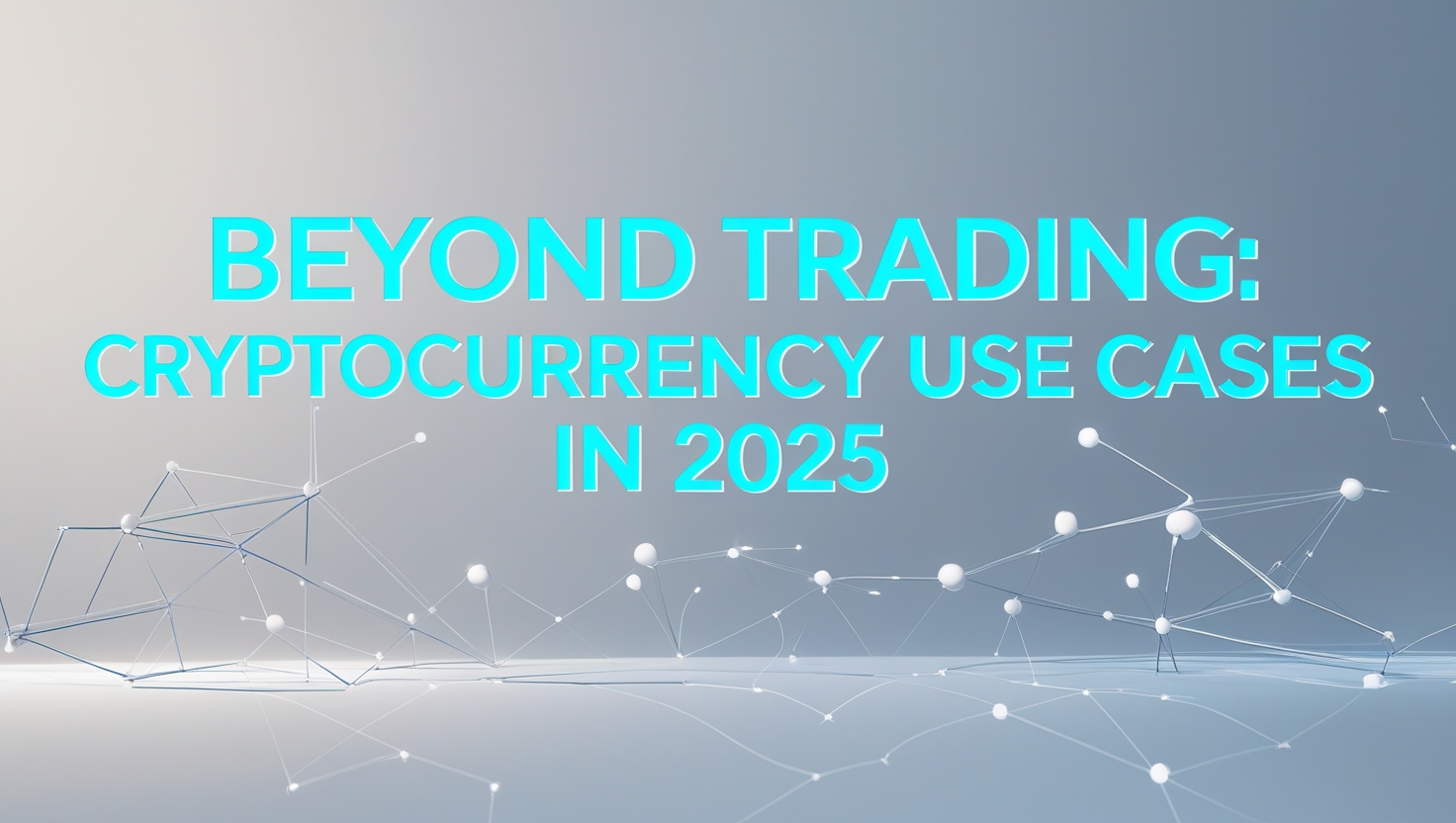
The crypto world has come a long way from the frenzy of 2022. Back then, many saw cryptocurrencies as either a speculative gold rush or a tool for tech-savvy criminals. Fast forward to crypto use cases 2025, and a more nuanced reality emerges. Yes, bitcoin and its peers are still traded on volatile markets, but they’re also quietly transforming how people send money, manage assets, verify identity, and even play games. This feature explores a range of real-world cryptocurrency use cases beyond trading – painting a 2025 landscape where blockchain tech is solving tangible problems (with a few growing pains along the way).
Payments and Remittances: Borderless Money Transfers
One of the clearest use cases of cryptocurrency in 2025 is as a payment rail for everyday transactions and remittances. In fact, sending money across borders via crypto is no longer a geeky experiment; it’s becoming mainstream. Bitcoin’s use case as “digital cash” has been supercharged by the Lightning Network, which allows instant, tiny payments.
“The same way [someone] pays for a cup of coffee in New York City is the same way [they] can now casually send $10 back home in Nigeria,” observed Bernard Parah, CEO of Bitnob, highlighting how user-friendly Bitcoin’s Lightning payments have become. Major exchanges and fintech apps integrated Lightning due to real user demand, giving hundreds of millions access to fast Bitcoin payments. The result? Communities from the Philippines to Nigeria are using sats (small bits of bitcoin) to remit money home in seconds – often for fees of just a few cents, a godsend compared to Western Union’s cuts.
Cryptocurrency Payment Solutions in 2025
Revolutionizing cross-border money transfers with drastically reduced fees and instant settlements
Bitcoin Lightning Network
Enables instant micropayments with fees of just a few cents
Example: Sending $10 from NYC to Nigeria as easily as buying coffee
Stablecoins (USDC, USDT)
$220+ billion in circulation by 2025
Used as unofficial reserve currencies in high-inflation regions
Specialized Remittance Coins
XRP and XLM designed for fast settlement
Cutting transfer costs from ~10% to fractions of a percent
Key Benefits
Decentralized Finance (DeFi): A Bankless Financial System
Beyond moving existing money, crypto has birthed an alternative financial universe called DeFi (Decentralized Finance). If you hear someone in 2025 say “I got a loan without a bank,” or “I’m earning interest on my crypto,” that’s DeFi in action. In contrast to 2022’s wild west of yield farms and rug pulls, the crypto use cases in DeFi by 2025 have matured (relatively!). Think of lending, borrowing, trading, and investing platforms – but open to anyone with an Internet connection, governed by code instead of bankers.
On Ethereum (ETH) – the epicenter of DeFi – users can lend out their crypto and earn interest, or borrow against holdings instantly. Platforms like Aave and Compound have for years let people use crypto collateral to access a loan in stablecoins within minutes, no credit checks needed. What started as a niche experiment now holds tens of billions in assets globally. Decentralized exchanges (DEXes) such as Uniswap process billions in daily trading volume, allowing users to swap tokens directly with one another without any central exchange or middleman. This peer-to-peer finance means markets are open 24/7 globally, and anyone can provide liquidity (and earn fees for it) akin to being their own market maker.
- Real-World Impact: DeFi is not just toy money anymore. By 2024, we saw traditional players dipping in – for example, tokenized real-world assets (RWA) became a buzzword. Government bonds, real estate, and invoices are being turned into tokens that can be traded or used as collateral on crypto platforms. This means an investor in Argentina could invest (via tokens) in a fraction of a U.S. Treasury bond or a pool of mortgages, things previously out-of-reach. Firms like Centrifuge and Maple Finance have been bridging real-world lending into DeFi, helping small businesses get financing by tokenizing their invoices or loans. By 2025, major banks and fintechs are exploring Ethereum-based networks to issue bonds or handle interbank lending, drawn by the lure of instant settlement and transparency. In fact, tokenized bonds are projected to reach $1 trillion by 2028 if current trends hold, signaling that institutions see this as more than a fad.
- Financial Inclusion: In regions where traditional banking is out of reach, DeFi offers a parallel system. Savers in Vietnam or Nigeria, for instance, can earn yield on stablecoins that far outpaces local banks’ rates, or secure a loan on DeFi when local banks won’t lend. This permissionless access was a dream in 2022; by 2025, ethereum use cases like micro-loans and community savings pools are materializing via DeFi apps on inexpensive blockchain networks.
DeFi isn’t without challenges – hacks and scams still occur, and regulators worry about unlicensed lending or money laundering. But even those hurdles have prompted improvements: audits are stricter, insurance funds backstop some protocols, and many teams work with regulators on compliant versions of DeFi (some call it “CeDeFi” when centralized institutions use DeFi tech). Despite a rocky road from 2022’s highs through the 2023 crypto winter, on-chain finance kept building. As one blockchain analyst noted, “permissionless, fair financial services” remain a cornerstone vision– meaning the goal is a financial system accessible to anyone, not just those with bank accounts or elite status. By 2025, we see that vision in action whenever someone anywhere in the world swaps tokens on a DEX or gets a crypto loan to start a business. It’s finance, but on crypto’s terms.
Supply Chain: Tracking Goods from Source to Shelf
What about the world beyond finance? One of the best crypto use cases materializing is in supply chain management – basically using blockchain as an unalterable ledger to track products and verify authenticity. This was a much-hyped idea a few years ago: remember the talk in 2018 of “blockchain tomatoes” and Walmart tracking lettuce on a ledger? Today in 2025, that hype has translated into some real deployments (and a few lessons learned along the way).
“Transparency and traceability are the key benefits. Companies can log each step a product takes on a shared blockchain.”
Real-world implementations include:
- Retailers verifying ethical sourcing of coffee and diamonds
- Luxury brands fighting counterfeit products with digital authentication
- Avery Dennison’s atma.io platform tracking billions of products using Hedera Hashgraph (HBAR)
- Pharmaceutical companies preventing counterfeit drugs
- IBM Food Trust tracing contaminated produce in minutes
| Industry | Application | Key Benefit |
| Retail | Origin verification | Consumer trust |
| Logistics | Shared documents | Reduced paperwork |
| Luxury | Authentication | Anti-counterfeit |
| Agriculture | Batch tracking | Food safety |
Not all early projects succeeded—Maersk and IBM’s TradeLens shut down in 2023 due to adoption challenges. However, specific use cases flourished where immutable shared records add genuine value.
One real-world example is Avery Dennison’s atma.io platform, used by manufacturers and retailers to track billions of products. In 2022, Avery Dennison announced it was integrating the Hedera Hashgraph (HBAR) distributed ledger to log item-level data and even carbon emissions for each product. By tokenizing each product’s carbon footprint on Hedera, they gave companies and consumers a transparent way to see the environmental impact of an item. This isn’t just a lab experiment – they literally planned to push billions of data points through Hedera’s network to connect physical products with digital records.
HBAR use cases like this show how enterprise blockchains can handle high volume: Hedera’s network is optimized for throughput, making it fit for supply chain traceability without slowing down. The result? Companies can generate “highly credible carbon reduction tokens” for products, helping meet net-zero targets and prove their progress to skeptical consumers. It’s a mouthful, but essentially blockchain is ensuring the sustainability data on a clothing tag or food label hasn’t been fudged.
In summary, use cases for crypto tech in supply chains have evolved: by 2025 we see less talk, more action in specialized, high-value areas like anti-counterfeit, ESG reporting, and trade finance. A factory in Bangladesh and a boutique in New York can now literally be on the same page (or rather, the same ledger) about the journey of a product, fostering trust in a way paper trails simply can’t.
Identity and Verification: Who Are You? The Blockchain Knows
Blockchain Identity Solutions (2022-2025)
Blockchain technology is revolutionizing digital identity management, giving individuals control over their personal data while improving verification processes.
The Future of Blockchain Identity
As of 2025, blockchain identity solutions are at a crossroads: they could either gain widespread adoption or remain limited by regulatory challenges. Key hurdles include:
- Regulatory compliance with privacy laws
- Digital inclusion for those without smartphones
- Interoperability between different ID systems
Gaming and NFTs: Digital Collectibles and Virtual Worlds Evolve
Remember when NFTs were the talk of the town in 2022? Those expensive digital art pieces and profile pictures that many of us dismissed as just another fad? Well, fast forward to 2025, and we’re seeing a more mature landscape where crypto in gaming actually makes sense. Players can now truly own their hard-earned in-game items – those special swords, unique skins, and rare trading cards – as NFTs they can freely trade outside the game. The smart studios aren’t even shouting “crypto” anymore; they’re just quietly giving us ownership of our digital stuff. Games like Gods Unchained and Sorare have kept their loyal fans who love being able to trade their digital treasures on open marketplaces. Even Nike jumped into the mix with their .SWOOSH collection, betting that we’ll care about our virtual sneakers as much as our real ones someday.
Enterprise and Government Blockchain Solutions: Back-End Revolution
While retail users see cryptocurrencies through the lens of tokens and apps, in boardrooms and government offices the conversation is about blockchain solutions. Enterprises in 2025 are no longer asking “what is blockchain?” but rather “which problems can it solve for us?”. The technology is being deployed in ways that regular folks might not even notice, yet it’s improving the plumbing of finance, supply chains, and governance.
Financial industry adoption is a standout. By 2025, traditional financial institutions maintain dedicated blockchain projects or even hold crypto on their balance sheets. Banks initially wary of crypto have realized they can harness the tech for efficiency gains.
Governments, too, are harnessing crypto technology (even if they don’t like volatile cryptocurrencies). Many central banks are developing Central Bank Digital Currencies (CBDCs) – essentially government stablecoins – inspired by the success of crypto and stablecoins in payments. China’s digital yuan project was a trailblazer, and by 2025 pilots for digital dollars or euros are underway, blending blockchain elements with centralized control.
Enterprise blockchain isn’t limited to finance. Sectors from healthcare to energy are finding niche uses:
- In healthcare, hospital networks use permissioned blockchains to share patient data securely and ensure medical records or drug supply data can’t be tampered with. For example, a blockchain might log every time a patient’s record is accessed or modified, creating an audit trail that boosts privacy and trust. Vaccine supply chains also utilized blockchain during COVID to track doses and prevent fake vaccines.
- In energy, blockchain is enabling new peer-to-peer power grids. Projects like Power Ledger and WePower let consumers with solar panels sell excess energy directly to neighbors using tokens. Instead of a central utility monopolizing energy distribution, these platforms create local marketplaces for renewable energy trading. Homeowners are literally earning crypto by feeding solar power into the grid, with smart contracts ensuring they’re paid fairly for each kilowatt. By 2025, several cities have pilot programs where communities trade energy via blockchain, improving grid efficiency and incentivizing green power. Moreover, Renewable Energy Certificates (RECs) – credits that certify renewable power generation – are being tokenized. Tokens like SolarCoin reward solar producers with tradeable coins, effectively monetizing eco-friendly behavior. These innovations make energy markets more transparent and could accelerate the transition to sustainable power by making it profitable at a micro level.
- In government and voting, a few brave jurisdictions experimented with blockchain-based voting or public records. For instance, West Virginia in the US trialed blockchain voting for overseas military voters, and some Swiss cantons used it in municipal referendums. While concerns remain (blockchain doesn’t magically solve all voting security issues, and some pilots were paused due to security reviews), the idea of a tamper-proof public ledger for votes is compelling. If each vote is a token and the blockchain is auditable by all, election fraud becomes extremely difficult – but balancing ballot secrecy with transparency is the tricky part.
- Document authentication is another enterprise use: from academic transcripts to business licenses, putting these records on blockchain ensures instant verification. A company hiring an engineer can quickly verify their university degree on-chain (as mentioned earlier), or a citizen renewing a license can do so online without risk of someone forging that license, since it’s traceable to the issuing authority’s blockchain key.
By 2025, the question of “should we use blockchain?” has shifted to “how can we use blockchain effectively?” Enterprises have become more clear-eyed: they deploy it when it adds efficiency, transparency, or security, and not just for buzz. Some early disillusionment (when pilot projects in 2018-2020 didn’t immediately revolutionize industries) gave way to practical, incremental improvements in 2023-2025. This mirrors the internet’s rollout – gradual and often invisible to consumers, but eventually indispensable. So next time you wire money and it arrives near-instantly, or you check a product’s QR code to see its origin, or you get a digital certificate via email that you can verify in seconds – you might just have an enterprise blockchain quietly to thank.
Addressing the Dark Side: Crime, Concerns, and Crypto’s Reality
No discussion of crypto use cases would be complete without touching on the elephant in the room: criminal activity. Cryptocurrencies gained early notoriety as the payment method of choice on darknet markets and for ransomware hackers. Scandals from the Silk Road marketplace takedown in the 2010s to high-profile exchange hacks in the late 2010s cemented an image of crypto as a Wild West. Skeptics in 2022 were quick to say, “Sure, you can use Bitcoin – if you’re buying drugs or laundering money.” So where do we stand in 2025 on this issue?
Share of cryptocurrency transaction volume associated with illicit activity (2020–2024). Illicit use (red) remains a tiny fraction of total crypto transactions.
Fortunately, data tells a different story than Hollywood thrillers. By 2024, known illicit crypto activity made up only 0.14% of total transaction volume– that’s only a few tenths of a percent, drastically lower than the 0.61% in 2023 and even higher in earlier years. In other words, over 99.8% of crypto transactions are NOT related to crime. Law enforcement has also gotten remarkably good at following the money on public blockchains.
The once-common assumption that Bitcoin is untraceable has been debunked as agencies use blockchain analytics to bust criminal rings. Crypto actually creates a paper (or rather, digital) trail. For example, U.S. authorities have recovered millions in ransomware payments by tracking and seizing wallets, something much harder to do with cash. Illicit actors have even shifted to privacy coins or layering through complex chains to try to hide, because using Bitcoin or Ethereum is like leaving a permanent record of your misdeeds.
Regulators worldwide clamped down in 2023-2024 to address these issues, implementing stricter KYC/AML (Know Your Customer / Anti-Money Laundering) rules for exchanges and crypto businesses. By 2025, most reputable exchanges require identity verification, and large transactions are monitored for suspicious activity, much like banks do. This has pushed a lot of criminal usage either into smaller offshore venues or into more trace-resistant coins. It’s a cat-and-mouse game: as enforcement increases, criminals adapt – but the playing field has dramatically changed from the early days when Bitcoin was the go-to for any illicit deal.
Conclusion: An Evolving Landscape Beyond Hype
Looking back at 2022, many crypto use case discussions were tinged with hype and hope. NFTs were selling for millions, DeFi yields were sky-high, every week a new project promised to put [insert industry here] on the blockchain. By 2024, a dose of reality set in: market downturns, regulatory crackdowns, and some high-profile failures forced the industry to reflect and rebuild. Now, in 2025, we find the crypto landscape transformed in subtle but profound ways. The use cases grabbing headlines today are often those delivering real What’s clear now is that cryptocurrencies are far more than trading vehicles. They are tools – sometimes blunt, sometimes elegant – being applied to real-world problems. As with any tools, success comes from using them in the right way. The period from 2022 to 2025 has shown a pruning of the garden: many frivolous ideas withered, while resilient use cases took root and grew stronger. A senior analyst recently described 2025’s crypto sector as having “overcome its earlier hurdles”, moving past the purely impulsive, hype-driven cycles of years past. In practical terms, that means a payment that arrives faster, a loan granted more fairly, a product made safer, an identity verified more securely – all thanks to that underlying blockchain infrastructure that Satoshi Nakamoto set in motion not so long ago.
As we stand in 2025, the question is no longer if crypto will find real utility, but rather how far will these use cases go? Will we see a day where virtually all financial transactions settle on crypto networks? Will gamers routinely expect to own and sell in-game items as easily as real-world toys? Can self-sovereign identity become the new normal, ending the reign of giant data silos? The groundwork is being laid now. The next few years will likely bring even more integration of crypto into the fabric of daily life, often in unseen ways, as well as new innovations we can’t yet predict (who had “eye-scanning orb” on their 2023 bingo card?).
In essence, cryptocurrency in 2025 is less a rebellious outsider and more a collaborative innovator in the global economy. The use cases of cryptocurrency span from banking the unbanked to streamlining corporate operations, from empowering creators to securing public records. And perhaps the most human aspect of this evolution is the tone: it’s natural, nuanced, sometimes even self-contradictory – just like this article, just like human progress. The hype has cooled, but the innovation engine hums on, solving real problems block by block, transaction by transaction. Beyond trading, crypto has found its footing in the real world, and it’s here to stay.
FAQ
1. What are the main cryptocurrency use cases in 2025 beyond trading?
By 2025, crypto is powering fast cross-border payments, decentralized finance (DeFi), supply chain transparency, digital identity verification, gaming/NFT ownership, and enterprise blockchain solutions in finance, healthcare, and energy.
2. How has cryptocurrency improved payments and remittances?
Through Bitcoin’s Lightning Network, stablecoins, and specialized remittance coins like XRP and XLM, users can now send money globally within seconds at just a fraction of the traditional cost.
3. What role does DeFi play in today’s financial system?
DeFi enables permissionless lending, borrowing, and investing without banks. By 2025, it has matured to include tokenized real-world assets, decentralized exchanges, and micro-loans, expanding financial inclusion worldwide.
4. How is blockchain being used outside of finance?
Blockchain is applied in supply chains for product authentication, ESG tracking, and food safety; in healthcare for secure patient records; in energy for peer-to-peer renewable trading; and even in government for voting and public records.
5. Is cryptocurrency still linked to crime in 2025?
Illicit use has dropped significantly—by 2024, only 0.14% of crypto transactions were linked to crime. Enhanced blockchain analytics and stricter KYC/AML regulations have made crypto more transparent and traceable than cash in many cases.
Our Review Methodology
We evaluate each post based on thorough research, credibility of sources, accuracy of information, and relevance to our readers. Our editorial team follows strict guidelines to ensure all content meets high standards of quality.
Disclaimer
The content in this article is provided for informational purposes only and does not constitute financial, investment, or professional advice. Always do your own research before making any decisions.


